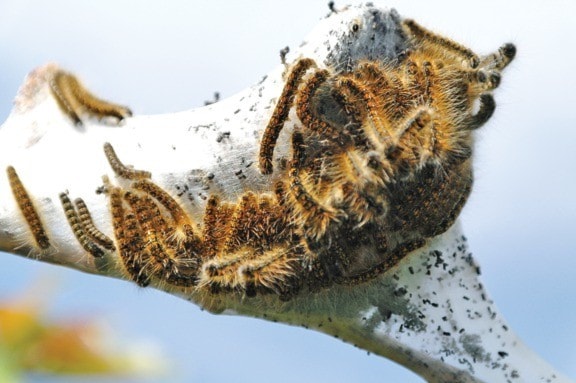An unusually large outbreak of northern tent caterpillars in Nanaimo is putting trees to the test this spring.
Northern tent caterpillars (Malacosoma Californicum pluviale), are the larva of the northern tent moth, a species native to B.C. with a range extending throughout the Pacific Northwest and as far east as Quebec.
This spring they are hatching in huge numbers and doing their best to defoliate trees with their voracious appetites.
Al Kemp, urban forests coordinator for the City of Nanaimo, said the outbreak is the worst he's seen in more than 20 years and complaints are coming into to his office from every part of Nanaimo and beyond.
"The problem is when we keep having mild winters, the eggs don't get frozen at all," Kemp said. "It's really bad and if it keeps staying like this, it's not going to get any better."
The caterpillars eat voraciously to support their rapid growth and must consume as much as possible while leaves are young, soft and digestible.
Red alder, cottonwood, willow, crab apple, flowering cherry, ash, birch, hazel, hawthorne, roses, arbutus, even garry oak are all on the menu, but fruit trees not native to B.C. are particularly susceptible to being stripped bare.
Tim Ebata, forest health officer with the B.C. ministry of forests, said native forests evolved to deal with the onslaught of large caterpillar outbreaks, which occur about every 10 years.
"With a lot of forest defoliators, you have this constant battle between its natural enemies and the insects' growth," Ebata said.
Caterpillar populations are usually kept in check by natural enemies that include parasites, such as flies and wasps, predators like birds and other insects, and diseases caused by fungi and viruses.
When the population explodes, it exceeds the control of natural enemies.
"In B.C., we have dozens of different kinds of defoliators that crop up across the province," Ebata said. "The northern tent caterpillar is a regular visitor. It will strip a lot of fruit trees and it will definitely have an impact on the amount of fruit and any other shrubbery that you hold near and dear to your heart."
Ebata said this year's outbreak extends throughout the B.C. coast and Lower Mainland.
The good news is northern tent caterpillars only hatch once each year and many trees will regenerate lost leaves later in summer after the feeding period ends.
And there are simple ways to help eliminate them.
The insects spin silk tents on tree branches used for warmth and protection, but leave the tents en masse to forage for food.
In the early morning or evening, when outside temperatures are low and the caterpillars regroup in their tents, Kemp recommends slipping a plastic bag around the tent and sealing it off to trap the insects inside. Snip off the branch, set it aside and the caterpillars will starve and die.
Kemp said caterpillar outbreaks are more of a nuisance or esthetic problem than a real danger to trees, unless they are repeatedly defoliated over multiple years to the point their ability to photosynthesize sunlight becomes so impaired the tree dies.
"It will take away their vigour and it will kill them," Kemp said. "So far, we haven't had that problem here."
An organic insecticide, sprayed to eradicate gypsy moths, will also kill the caterpillars, but it is not selective and will kill other moth and butterfly larvae.
The city used the spray last weekend, Kemp said, to kill caterpillar masses in downtown Nanaimo.
"We were getting so many complaints we brought in our boom sprayer and sprayed the trees, but in general terms, we don't like to use it," Kemp said. "Gypsy moths are different because they will kill trees."
